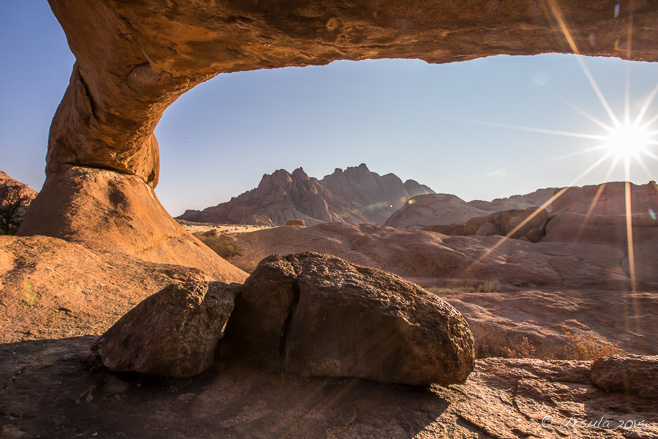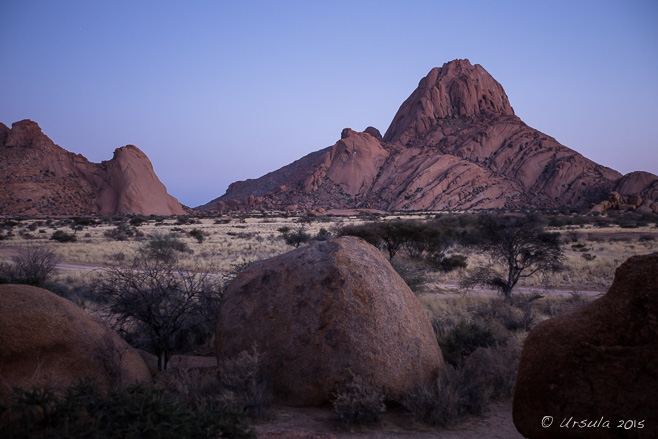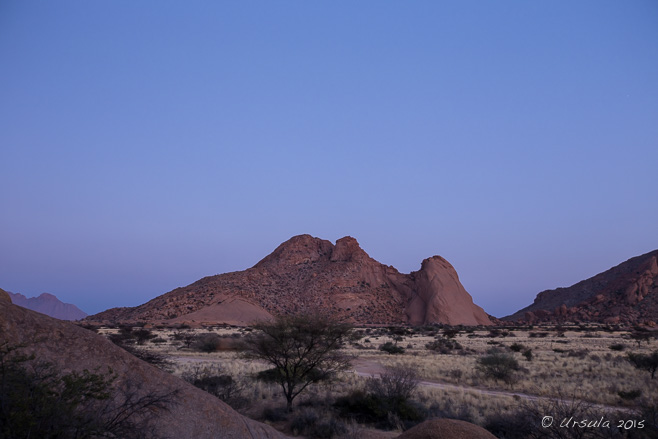
Sunburst over the Pontoks
More than a 100 million years of wind erosion have acted on an ancient, collapsed volcano to carve out some extraordinary granite-rock shapes – shapes that rise high out of the surrounding flat expanse that is the Namib Desert.
The Spitzkoppe, meaning “pointed dome” in German, is a granite massif rising out of the flat Namib Desert – a plain of gravel and sand that extends to the Atlantic Ocean a hundred miles away on Namibia’s west coast. Part of the Erongo Mountains, Spitzkoppe is the remains of a gigantic volcano which collapsed more than a 100 million years ago when the ancient continent of Gondwana was splitting into the continents of Africa, South America and Australia.
In a process referred to as inselberg (German for “island mountain”) formation, erosion of the softer outer layers of rock result in an isolated rock hill, knob, ridge, or small mountain that rises abruptly from a gently sloping or virtually level surrounding plain. The resulting granite formations are abundant in southern and south-central Africa, where they are commonly called koppie, an Afrikaans word meaning “little head”, from the Dutch word kopje.
I was camped out at the Spitkoppe Campsite with photographer Ben McRae, Pedro Ferrão Patrício from Photoburst, Namibian guide Morne Griffiths, and four other photography enthusiasts. We were there to photograph the myriade of stars that shine through the clear winter night skies over the Spitzkoppe.
The sunrises and sunsets are meant to be especially beautiful in the summer months. Even though it was the wrong season, and as much as I don’t like mornings, having dragged my tripod across four continents to get to Namibia, I was determined to take in the morning light.

Spitzkoppe in the Pre-Dawn Light
When my alarm went off, all around me was dark. With a cloudless sky and no moon, my head-lamp and torch were the only lights, and they found little purchase in the gravel paths and thorny bushes. Even though I had checked out locations the day before, I made several wrong turns into blind alleys in the rock formations before clambering, with cameras and a tripod, up to the Rock Bridge.

Granite Peaks
The pre-dawn winter light over the plains and peaks in the Spitzkoppe area is clear and cold, affording slowly emerging views over the Pontoks as they rise out of the Namib Desert.

Spitzkoppe on the Plain
Slowly, pink light creeps over the horizon.

Spitzkoppe through the Rocks
Morning light warms the granite of Spitzkoppe – but most of the landscape remains in shadow.

Spitzkoppe through the Rocks
Moment by moment, the light changes. I am glad to have the tripod, so that I can take the long exposures necessary to find subtle colours and details in the low light.

Spitzkoppe and Pontoks from the Rock Bridge
As the sun rises higher in the sky, I climb up and under the Rock Bridge to get a better view.

Pontoks from the Rock Bridge
Like specks on the rocky outcrop, two of my companion photographers stand with their tripods. (iPhone 6)

Spitzkoppe from the Rock Bridge

Behind the Rock Bridge
Gradually, the light works over the surrounding mountains and starts to angle across the other granite rock formations.

Sunrise over Spitzkoppe and the Pontoks

Desert Bush
An inselberg, or koppie, traps wind-blown soils and moisture, so many plants which can’t survive on the almost-barren plains grow there. Spitzkoppe’s desert vegetation clings to life, thorny and tough.

Creatures in the Morning Light
Wind erosion over the millennia has given rise to a number of bizarre rock formations. I kept coming back to this grouping which made me think of rabbits and puppies.

African Mourning Dove (Streptopelia decipiens)
Back at the campsite, a mourning dove sits in a thorn tree while we have breakfast.

Mother and Child
Before long, the light is too strong for landscapes, and the day turns hot. We break camp, and stop at the “craft” stands before we leave the area.

Young Girl with Attitude
Children from the local Damara community are on hand to talk to tourists and help sell the mobiles made from scrap tin, cloth bags sourced from elsewhere, and gems collected from the surrounding mountains.

Girl with Apples
This area has very limited water resources …

Girl with Orange
… so the children appreciate the fruit Ben has brought for them.

Damara Man
This 47-year-old husband and grandfather cuts animal shapes for mobiles from bits of jagged tin.

Damara Woman
His 44-year-old wife – who is wearing Himba ochre on her face as sunscreen – paints and strings them.

Damara Boy
Their grandson watches the visitors solemnly.
The lands here were expropriated (with compensation) from their Afrikaans owners in 1964 and resettled with Damara families in 1970. Recently – in addition to eking out a living livestock-farming and selling crafts to passing tourists – part of the community has taken over management of the campsite.

Mother and Child
It is clearly not an easy livelihood…

Young Girl
… but the kids are bright and sassy.
I always have mixed feelings chatting with the children at these remote outposts about their schooling and their dreams. They are lively and engaging, and clearly part of a larger community. But, their access to formal education and their ability to make choices is sorely compromised. Private investment in local resources can clash with traditional values, and communities can become divided over decision-making processes. The community here is facing issues over land and water management. Who knows how it will play out over time.
 I can only wish these youngsters luck in the future ~
I can only wish these youngsters luck in the future ~
And hope someone continues to bring them bits of fresh fruit in the meantime.
Pictures: 13August2015


























.png)


[…] northerly part, with its clear skies (see: A Sky Full of Stars) and dramatic rocky outcrops (see: Morning over Spitzkoppe), leaving the ocean and the sand dunes behind […]
Ursula,
the desert images are spectacular. the boulders’shapes and vegetation makes it look like huge prehistoric animals are still living there. Congratultions!!!
Ruti
Thanks, Ruti – it IS an amazing landscape!